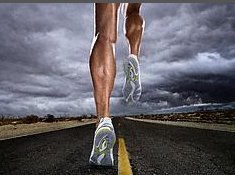How to jogg
before, while and after jogging
6. Relax your fingers, hands, arms, shoulders, neck, jaw. When you jog efficiently you'll use as few muscles as possible, thus decreasing fatigue.
7. Carry your arms at about a right angle. Don't let your arms cross in front of your body. Relax your wrists, but carry your hands strongly thumbs up. Relaxing doesn't mean flopping.
8. Breathe from your belly, through your nose and mouth.
9. While jogging, the inner borders of your shoes should fall very close to an imaginary line extending directly out in front of you.
11. Variety will help you jog your best. Continually jogging in a straight line on the flat uses the same muscles, in the same ways, over and over, training them, but leaving other leg muscles out of shape. This classic imbalance tends to lead to injury since you don't have well-rounded muscle support for proper mechanics. Break up your jogs, not only with stretching exercises and walking, but by searching out the corners, circles, stairs, and hills.
12. Walking, called "the pause that refreshes", is an excellent break from jogging and can help you increase your distance without strain. Every 15 minutes of jogging you might want to try 5 minutes of walking.
13. After jogging, a cool-down period of 5 — 15 minutes is recommended.
14. Do you have appropriate clothing? Lay in a supply of cotton or wool athletic socks. Clean, good socks are a must for comfort and in order to avoid blisters . Make sure your clothing doesn't bind you. An expensive warm-up suit may help your motivation, but an inexpensive sweat suit is just as appropriate. Many men prefer an athletic supporter. Many women prefer a bra. If you are comfortable in one, fine; however, jogging without them is in no way dangerous, does not lead to sagging, and is not unhealthy unless you have a special need for support.
If it is a hot day dress coolly and loosely. If it is cold, dress in layers so you can add or subtract as the temperature changes.
Warming up
A warm-up should have two parts, the first being to stretch muscles and joints before taking your first jogging step. The second part of a good warm-up involves using the muscles that are going to be involved while jogging: the cardiovascular system and legs. This is done by beginning your jog slowly, allowing your body to become adjusted to the new demands you are putting on it before picking up your pace. This will usually take 5 — 10 minutes.
What's important is to begin to get into the habit and schedule of regular, long, endurance exercise.

